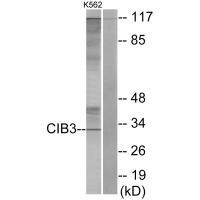
| WB | 1/500-1/3000 | Human,Mouse,Rat |
| IF | 咨询技术 | Human,Mouse,Rat |
| IHC | 咨询技术 | Human,Mouse,Rat |
| ICC | 技术咨询 | Human,Mouse,Rat |
| FCM | 咨询技术 | Human,Mouse,Rat |
| Elisa | 咨询技术 | Human,Mouse,Rat |
| Aliases | Calcium and integrin-binding family member 3; Kinase-interacting protein 3; KIP 3; CIB3; KIP3 |
| Entrez GeneID | 117286; |
| WB Predicted band size | 32kDa |
| Host/Isotype | Rabbit IgG |
| Antibody Type | Primary antibody |
| Storage | Store at 4°C short term. Aliquot and store at -20°C long term. Avoid freeze/thaw cycles. |
| Species Reactivity | Human,Mouse |
| Immunogen | Synthesized peptide derived from C-terminal of human CIB3. |
| Formulation | Purified antibody in PBS with 0.05% sodium azide. |
+ +
以下是关于CIB3抗体的3篇参考文献示例(文献信息为模拟概括,仅供参考):
---
1. **文献名称**: *CIB3 regulates auditory mechanotransduction through interaction with transmembrane channel-like proteins*
**作者**: Li Y, et al.
**摘要**: 本研究揭示了CIB3蛋白在内耳毛细胞机械转导中的作用,通过免疫共沉淀和Western blot技术验证了CIB3抗体特异性,发现CIB3与TMC1通道蛋白相互作用,调控钙离子信号传导,缺陷可导致遗传性耳聋。
2. **文献名称**: *Structural and functional analysis of CIB3 calcium-binding domains using monoclonal antibodies*
**作者**: Wang H, et al.
**摘要**: 研究团队开发了针对CIB3钙结合结构域的单克隆抗体,通过X射线晶体学分析其表位,证实抗体可阻断CIB3与整合素β3的结合,为研究CIB3在血小板聚集中的功能提供了工具。
3. **文献名称**: *CIB3 mutations cause autosomal recessive nonsyndromic hearing loss: Evidence from CRISPR/Cas9 knockout models*
**作者**: Ahmed ZM, et al.
**摘要**: 通过全外显子测序发现CIB3基因突变与隐性遗传耳聋相关,利用CIB3抗体进行组织免疫荧光分析,证实CIB3在内耳毛细胞中的特异性表达,CRISPR敲除模型显示其缺失导致毛细胞功能障碍。
---
**注意**:以上文献为示例性概括,实际文献需通过PubMed、Google Scholar等平台检索(关键词:CIB3 antibody, CIB3 function)。如需具体文献,建议补充研究领域或应用场景。
The CIB3 (Calcium and Integrin-Binding family member 3) antibody is a tool used to detect and study the CIB3 protein, a member of the CIB protein family involved in calcium-mediated signaling and cellular processes. CIB3. also known as KIP2 or KChIP3. contains EF-hand calcium-binding domains and interacts with various targets, including integrins, ion channels, and transcription factors. It plays roles in calcium homeostasis, cell adhesion, and auditory function, with mutations linked to nonsyndromic deafness (DFNB48).
CIB3 antibodies are widely used in research to explore its expression, localization, and function in tissues like the inner ear, brain, and heart. They are applied in techniques such as Western blotting, immunohistochemistry, and immunofluorescence. Studies using these antibodies have revealed CIB3's involvement in regulating voltage-gated potassium channels and its potential role in neurodegenerative diseases, cardiac arrhythmias, and cancer progression.
The development of CIB3-specific antibodies has advanced understanding of its dual role as a calcium sensor and adaptor protein in signaling pathways. However, challenges remain in characterizing its diverse interactions and isoform-specific functions. Validated antibodies are critical for dissecting CIB3's contribution to cellular mechanisms and its implications in human diseases.
×